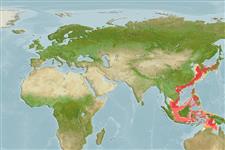Actinopterygii (ray-finned fishes) >
Perciformes (Perch-likes) >
Scombridae (Mackerels, tunas, bonitos) > Scombrinae
Etymology: Scomberomorus: Latin, scomber = mackerel + Greek, moros = silly, stupid (Ref. 45335).
Environment / Climate / Range
Ecology
Marine; freshwater; brackish; pelagic-neritic; amphidromous; depth range 10 - ? m. Subtropical, preferred ?; 41°N - 14°S, 102°E - 140°E (Ref. 168)
Western Pacific: Akita, Honshu, Sea of Japan, Yellow Sea and China south to Vietnam and Cambodia where it enters the Mekong River.
Size / Weight / Age
Maturity: Lm ? range ? - ? cm
Max length : 247 cm TL male/unsexed; (Ref. 83530); common length : 100.0 cm TL male/unsexed; (Ref. 27773); max. published weight: 131.00 g (Ref. 83530)
Dorsal
spines
(total): 15 - 17;
Dorsal
soft rays
(total): 15-17;
Anal
spines: 0;
Anal
soft rays: 16 - 19;
Vertebrae: 41 - 42. Interpelvic process small and bifid. Body covered with small scales. Lateral line abruptly curving down below first dorsal fin. Intestine with 2 folds and 3 limbs. Swim bladder present. Sides silvery with large round, indistinct spots in two poorly defined rows in adults. Juveniles with saddle-like blotches extending down to about middle of body.
Travels 300 km up the Mekong River, above Phnom Penh but believed to reproduce only in marine waters. Feeds on fishes and swims well upstream river because of easy food availability (Ref. 12693). No information on biology available (Ref. 9684). It is a prized food fish in Japan and probably in China as well. Utilized fresh, dried or salted and smoked; consumed pan-fried, broiled and baked (Ref. 9987).
Life cycle and mating behavior
Maturity | Reproduction | Spawning | Eggs | Fecundity | Larvae
Collette, B.B. and C.E. Nauen, 1983. FAO Species Catalogue. Vol. 2. Scombrids of the world. An annotated and illustrated catalogue of tunas, mackerels, bonitos and related species known to date. Rome: FAO. FAO Fish. Synop. 125(2):137 p. (Ref. 168)
IUCN Red List Status (Ref. 115185)
CITES (Ref. 94142)
Not Evaluated
Threat to humans
Harmless
Human uses
Fisheries: commercial; gamefish: yes
More information
ReferencesAquacultureAquaculture profileStrainsGeneticsAllele frequenciesHeritabilityDiseasesProcessingMass conversion
Tools
Special reports
Download XML
Internet sources
